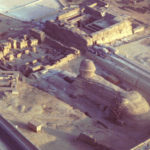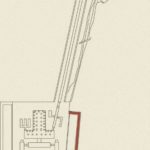Sequencing tells us which happened first
When was the Sphinx built? The archaeological evidence points with a high degree of probability to the reign of Pharaoh Khafre, rather than to much earlier dates proposed in recent popular theories. Archaeological sequencing at the Sphinx supports the Khafre date. Sequencing in archaeology looks at when one event happened in relation to another.
Egyptian architects created funerary monuments in somewhat standard sets. During the period of pyramid building, the set generally consisted of a pyramid, pyramid temple, causeway, and valley temple. Some pyramid complexes included queens’ pyramids.
Khafre’s building program differed from standard Old Kingdom pyramid complexes in that it included his pyramid, the Sphinx, Sphinx Temple, causeway, and Valley Temple, but did not include pyramids for the pharaoh’s queens.
Respecting walls
Two temples occupy a low terrace in front of the Sphinx: Khafre’s Valley Temple at the end of his pyramid causeway and the Sphinx Temple.
Khafre built enclosure walls north and south of his Valley Temple. Parts of the south wall still exist, but the ancient builders removed most of the north wall.
You can still see the foundation track for the northern enclosure wall stones in front of the southeast corner of the Sphinx Temple. Part of the wall was incorporated into the southern wall of the Sphinx Temple.
The western end of the southern Valley Temple enclosure wall turns a corner and attaches to the southern side of the Temple. The last block still fits over and “respects” the small granite block of a low bench, which ran along the south, east, and north sides of the Valley Temple.
In archaeology we say that one element respects another when the evidence reveals that builders worked around an earlier structure when building a later structure.
For example, if you had a fence that stopped at the wall of your house, we’d say that the fence respects the house wall.
If we found that the foundation cut across the line of holes dug for the fence posts, we would say the house foundation post-dates the fence line. We can then sequence the fence and the house foundation in the order of time that they were built. In the latter example the fence line was built first.
Since Khafre’s Valley Temple enclosure wall respects the granite casing on Khafre’s Temple, the wall was built after the casing was in place. This is important when we then try to sequence the adjacent Sphinx Temple.
Ancient recycling
When Khafre’s architects built the Sphinx and the Sphinx Temple, they removed the northern Valley Temple enclosure wall leaving a portion of it in place, incorporating that leftover part into the new Sphinx Temple southern wall.
So we can say:
- The Valley Temple enclosure wall respects the Valley Temple casing stones.
- The Valley Temple therefore predates its now-missing northern enclosure wall.
- Part of the Valley Temple enclosure wall was later incorporated into the Sphinx Temple southern wall.
- The Sphinx Temple was therefore built later than the Valley Temple.
This becomes even more important when you look at clear evidence indicating that the stones for the Sphinx Temple came from the lowest layers of the Sphinx quarry. We can sequence three of Khafre’s monuments in the following way:
- The Sphinx is carved from the same quarry as the core blocks in the two lower Khafre temples.
- The Sphinx Temple was built using blocks from the Member II layer of the Sphinx quarry.
- The core blocks of the Sphinx Temple are matched geologically and archaeologically to the lower layers of Member II of the Sphinx quarry, indicating that the Sphinx lower body and Sphinx Temple were part of the same quarry-construction sequence.
There is no current evidence (that stands up to the scrutiny of science) pointing to any other date for the Khafre monuments. The best statement science can make is that with a high degree of probability the Sphinx and the Sphinx Temple were constructed late in the sequence of the Khafre building program during the reign of that king.
For more on AERA’s work with the Sphinx, see AERAGram Vol. 5 No. 2, Spring 2002.



